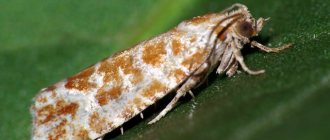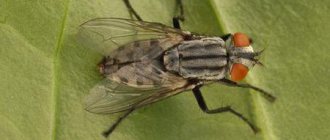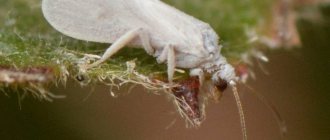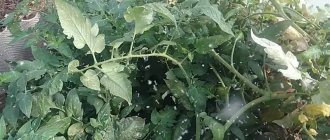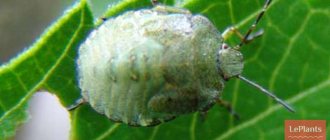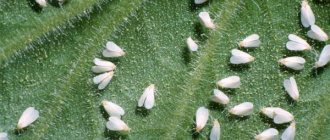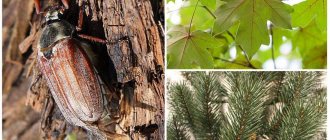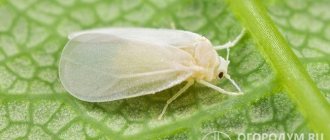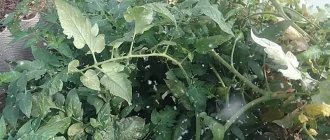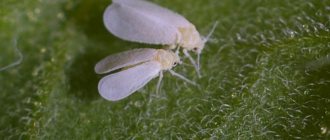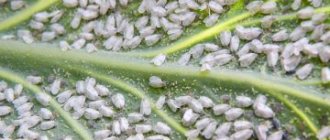This pest is very easy to notice, because white wings on green leaves can be seen from afar... This is what inexperienced gardeners think. In fact, the whitefly is a secretive and cunning enemy. Until the number of insects increases, whitefly individuals move exclusively along the underside of leaves, without revealing themselves in any way.
Sooner or later, the flower is shaken and then a white cloud consisting of tiny insects rises around it. It hangs in the air for a while, and then confidently heads towards a neighboring plant. The whitefly went on the attack...
Description
It is difficult to find a problem larger than whitefly in a greenhouse. Small insects are unremarkable at first glance, but if you don’t fight them, you can lose your entire harvest by autumn. Plants in a greenhouse are most often attacked by these midges, since favorable conditions are created here for their reproduction. Most often, tomatoes, potatoes, cucumbers, peppers, and eggplants are affected. The greenhouse whitefly is no different in appearance from its counterpart, which settles in open ground.
The adult insect and the larva feed on plant juices, thereby inhibiting its growth and development. As a rule, whiteflies settle on a bush in a whole colony, quickly multiplying and causing irreparable damage. Therefore, when the first signs appear, you need to immediately begin to destroy the pest. But that’s not the only thing that’s scary about this little midge. Its secretions are excellent soil for sooty fungus, which spreads throughout the bush. And we already have to deal with two troubles.
In a greenhouse, the whitefly reproduces even better than in the open ground, since all the conditions for its habitat are created here: no wind, warmth, high humidity and a lot of juicy food. The insect is small and dies at temperatures less than +10C. The life cycle is quite short. The greenhouse whitefly lives for about 30 days, but during this time the female manages to lay up to 130 eggs. Over the course of a month, all stages of development go through: pupae turn into larvae, and those, in turn, into adult midges. The difficulty in identifying the pest is that it is hidden on the inside of the leaves. Therefore, a sign of its appearance is the darkening of the leaf due to the appearance of sooty fungus and inhibition of the growth of the plant itself. In the fall, when it gets cold, the greenhouse whitefly dies, but the larvae overwinter in the ground and wake up with the onset of warmth.
Time factor
Why did it happen? Because there is an exposure (holding) time for the infusion - two days, and you also need to add a little to prepare the working solution, and wait until the evening so that the plants in the greenhouse do not feel bad on a sunny day. As a result, it turns out that three days are lost. So they played a fatal role for my neighbor’s tomatoes, which were destroying hordes of pests.
Whiteflies reproduce very quickly. Photo from agroflora.ru
After all, all these days the whitefly hatched from previously laid eggs, multiplied, and laid eggs again (it produces up to 10 generations in the greenhouse season, under good weather conditions). I didn’t know that I should sit quietly and wait for the tobacco potion to be prepared.
Whitefly
In recent years, this small insect has become notorious among both gardeners and lovers of indoor and greenhouse plants. Yes, the whitefly easily penetrates not only into open areas, but also into greenhouses, and even into apartments and houses. This pest gets its name from its small, mealy-colored wings. In general, it is worth noting that the whitefly is not large in size - a maximum of 3 millimeters in length (Photograph). However, anyone who is familiar with this pest will say that it is not so much a matter of size as it is the number and survival rate of the parasite.
Why is whitefly so harmful? The adult insect feeds on the juices of plants, including weeds, but gives preference to tomatoes, cucumbers, peppers, and cabbage. The appearance of a pest is signaled by black, greasy spots on the leaves. If you do nothing, after a while tiny white dots will appear on the underside of the leaves. They indicate that insects have taken a fancy to your greenhouse and are in a hurry to give birth to offspring, which can destroy most of the crop. Soon thousands of larvae will leave their puparia and begin sucking the juices from the plant (Photo). The leaves will be covered with a black coating (larval excrement) in which various fungi will settle. This plaque will block the path of the sun's rays, which means it will stop photosynthesis. It is clear that in such conditions your plants are doomed to death.
This scenario was repeated many times, which gives reason to assert: whiteflies in a greenhouse are much worse than late blight, powdery mildew or the Colorado potato beetle. The worst thing is that today there is no universal remedy that can put an end to this insect once and for all. If you want to protect the harvest in your greenhouse, you will have to take a whole range of measures to combat the pest. Let's first analyze the measures that should be taken to prevent the appearance of whiteflies in a greenhouse.
Work to prevent the appearance of insects in your greenhouse should begin in the fall, immediately after harvesting.
- Remove all plants, dry leaves and stems from the greenhouse - completely empty the greenhouse and cover the soil with cellophane film;
- Using chemicals, disinfect all frames, inter-frame spaces and other parts of the greenhouse. Blow out hard-to-reach places with insecticides; accessible parts can be painted with regular paint;
- After a few days, repeat the chemical treatment of the greenhouse. According to reviews from gardeners, the drug Aktara is best suited for these purposes.
After disinfecting the greenhouse itself, it is necessary to destroy the whitefly in the soil:
- Remove the film and dig up the ground adding slaked lime or ash. The fact is that the whitefly cannot tolerate an alkaline environment;
- Buy several sulfur or tobacco checkers (Pawn-S, Hephaestus) and fumigate the internal space (Photograph). In this case, the greenhouse room must be well insulated. Only after a few days can you open and ventilate the greenhouse.
Important: smoke from bombs kills adults and larvae, but does not cause any harm to whitefly eggs. Therefore, soil disinfection is a mandatory procedure.
- At the first severe frost, it is necessary to freeze the greenhouse, since the whitefly cannot tolerate the cold. It should be borne in mind that insects feel comfortable under the snow, so you need to freeze the room before the first snowfalls or by removing snow from the ground;
- Don’t forget to disinfect the gardening tools you use in the greenhouse – there may be whitefly eggs on them;
- Pay attention to the area around the greenhouse. Remove all weeds, disinfect the soil around the perimeter of the room;
- Sow dill, celery, and parsley at a short distance from the greenhouse. These plants will attract lacewings, ladybugs and some other insects that are the natural enemy of the whitefly and will destroy the pest when it appears;
- In the spring, hang traps around the greenhouse; you can make them yourself from cardboard or polycarbonate, or you can buy them in specialized stores. Particularly popular are glue traps such as Pheromone, Bona Forte, ARGUS;
- When planting seedlings, make sure that there are no whitefly eggs or larvae on them.
Tobacco smoke bomb for greenhouses
Mechanical way of fighting
The mechanical method refers to the fight against whiteflies using a powerful jet of water. This is a dubious method because it is difficult to destroy all the midges hiding under the sheets. After this, make soapy water and wipe the leaves with a sponge. The soap solution is prepared from 100 g of laundry soap shavings per 600 ml of warm water. But experts recommend using tar soap, because its smell additionally repels insects.
If the greenhouse is small and there are few plants in it, then this method is suitable. It is also useful for treating indoor plants. But for large areas it is not effective. Therefore, you can hang traps with adhesive coating. These are used to catch flies. Making a sticky trap with your own hands is very simple. Take castor oil, honey, petroleum jelly and rosin, mix and spread on plastic or thick cardboard. The smell attracts midges and they stick to the surface. By regularly replacing the adhesive tape, you can significantly reduce the midge population.
Fumigators can be used for greenhouses. By releasing harmful substances, they poison the whitefly. But it should be remembered that people cannot be in the greenhouse while the fumigator is running.
Prevention
- Constant inspection of the leaves will help to detect the insect in time. New plants in the house should be quarantined.
- Because whitefly is most common indoors, it is important to thoroughly clean and disinfect greenhouses and conservatories after harvest. Plant residues and weeds are collected and disposed of or composted. The soil is turned over and leveled only in the spring.
- In summer, screens are placed on doors and shutters to prevent insects from entering.
- Greenhouses are cleaned and disinfected, paying attention to cracks and joints. After the onset of cold weather, it is best to leave the windows and doors open so that the pests that have settled there for the winter die. At temperatures of -12°C and below, it is enough to freeze the greenhouse for a week.
Although the whitefly multiplies quickly, it can and should be combated. Only systematic actions will help get rid of it. Once you start fighting it, don't stop!
Learn more about whitefly control in this video.
Description of the pest
An adult whitefly (Aleyrodidae) resembles a miniature snow-white moth - its body length does not exceed 2 mm. But this gentle, at first glance, creature can be compared to a powerful pump, so actively does the insect suck out the juice from the leaves of plants (cucumbers, tomatoes, cabbage and many other crops). They stop developing, refuse to bloom and bear fruit normally, and when pests dominate, they often die.
The tiny whitefly butterfly is unusually voracious. The whitefly feels great in the greenhouse. A windless, warm microclimate (this heat-loving insect dies when the temperature drops below +10°C), high humidity and an abundance of succulent foliage perfectly contribute to its active reproduction. One female lays up to 130 eggs during her 30-day life, which she spends tirelessly absorbing plant sap. After 20-40 days, having passed the larval stage, a new army of butterflies is ready for battle. The larvae, like the “mothers,” feed on plant sap and are practically indistinguishable to the naked eye - their body length is only 0.3-0.9 mm. Adding to the inconvenience in recognizing this tiny enemy is its secretive lifestyle - insects usually huddle on the inner surface of leaf blades.
Butterflies and whitefly larvae huddle on the inner surface of the leaves. The first signs of a pest invasion are as follows: slow growth of plants, their depressed appearance, brittle shoots, as well as yellow spots on deformed leaves. A distinctive feature of the whitefly’s activity is a sticky coating on the foliage of vegetables, which in turn becomes a favorable environment for the proliferation of spores of fungal diseases. If you find such huddled and “sticky” plants in your greenhouse, and when you shake them, a flock of small white moths timidly fly to neighboring bushes, immediately begin to defend yourself. Delay in this case can lead to the most disastrous consequences. Tiny “pumps” will quickly multiply to incredible numbers and destroy your entire crop.
Chemicals
It should be noted that almost all of the drugs listed below are very good and effective. The main thing is to strictly follow the instructions and observe safety measures when processing plants, since the toxic substances included in the composition are harmful to humans.
"Aktar". Treatment with this substance helps remove whiteflies for a period of up to 1 month. Treatment is repeated 3 times every 7 days to destroy midges in all life cycles of development. Vegetables can be eaten only after 60 days after the last application of the drug "Aktar". 1 sachet, containing 4 g, is diluted in 5 liters of water. This is enough for a large greenhouse area. To destroy, spray and water at the root.
"Aplaud." Can be used both in greenhouses and in open ground. Japanese insecticide allows you to get rid of insects for 1 month. Diluted 0.5 kg per 1 ha. To process 1 hectare you will need 1500 liters of water.
"Confidor". The drug is quite effective, so one treatment is enough. After an hour, the midges begin to die.
"Iskra Golden" These are tablets that easily dissolve in water. Also available in the form of ampoules, powder and sticks. A solution of 2 ml per 10 liters of water is prepared and sprayed on the plants. 1 or 2 treatments with Iskra Zolotoy are enough.
"Tanrek". A very effective and low-toxic substance that practically does not accumulate in fruits. To spray vegetables and indoor plants, you need to take 5 ml of the drug per 10 liters of water, for trees and bushes, 3 ml. Safety precautions must be observed when working with Tanrek, so be sure to wear respirators or face masks.
Fumigators
Some savvy gardeners rid the greenhouse of whiteflies using fumigators designed to control mosquitoes and flies. To do this, extend an extension cord to the room and attach a fumigator with repellent liquid or plate to the outlet.
Mosquito fumigators also have a detrimental effect on whiteflies. The device is left in the active state, after closing all the windows and closing the greenhouse door tightly. After a few hours, the pests die. True, in an unequal battle with the “fragrant” fumigator, many other insects, including beneficial ones, also lay down their heads.
Using smoke bombs
Fumigation with sulfur dioxide is a radical and effective method in pest control. Poisonous gas gets into all hard-to-reach places, deep into the ground. This way the insects are destroyed. Smoke bombs made from tobacco also have a detrimental effect.
To carry out cleansing in this way, you need to seal all the cracks. Place the checkers on stands made of non-flammable material and set them on fire. Quickly leave the premises and close the doors tightly.
Enter the greenhouse no earlier than after 3 days.
To increase the effect, it is recommended to pre-humidify the room.
Traditional methods
Gardeners and summer residents in their small plots prefer to cope with the invasion of the parasite using traditional methods. The advantage of these methods is the absolute environmental friendliness of the fruit.
- An effective method is wiping with water. But the method is only suitable for indoor plants and a small number of seedlings. Take a sponge, soak it in water and wipe the leaves with it. The method is painstaking, but you know for sure that you have removed all the larvae.
- The composition of water and laundry soap is prepared in the proportion of 1 part soap to 6 parts water. Water the soil, but not too much, so as not to harm the roots and plant. Repeat in a week.
- Garlic tincture is prepared from 2 large cloves of garlic and 1 liter of hot water. Leave it to sit overnight and then you can spray it on.
- Yarrow tincture is prepared at the rate of 90 g of leaves per 1 liter of water. Let it brew for 2 days and spray the plants or seedlings. Repeat 3 times every other week.
- Tobacco solution. Experienced gardeners recommend using Prima cigarettes. The tobacco from them is poured into a jar and filled with water. Let it brew for 5 days, strain and spray. Repeat the treatment until the midges completely disappear.
- Dandelion tincture is prepared from 40 g of leaves, 40 g of roots, which are crushed and filled with water. Let it brew for 4 days, strain and process the plants.
- Ammonia is diluted 35 ml per 1 bucket of water. Treatment with ammonia is carried out every 3 days.
- Birch tar is part of tar tincture. Dilute 5 ml per 10 liters of water.
- The vinegar solution is prepared as follows: take 5 tablespoons per 10 liters of water. vinegar essence.
Resistant tomato varieties
Among the resistant varieties of tomatoes are: “Fluffy pink F1”, “Fluffy red F1” and “Algol F1”.
Whitefly, portrait of a pest
Whiteflies, or aleurodids (lat. Aleyrodidae) are a family of small homoptera insects (Homoptera) from the suborder Sternorrhyncha (Hemiptera).
There are about 1550 species in the family. The scientific name comes from the Greek word aleuron (flour) due to the powdery coating on the wings, and the Russian name comes from the presence of 2 pairs of white wings (from Wikipedia).
These insects can settle on absolutely all plants in a garden plot, and also love to settle in greenhouses. And this is no coincidence, because their homeland is South America, where it is always warm. And it is the greenhouse climate that is most comfortable for them.
If you take a closer look at them, they are very small butterflies, no more than 2.5 mm in size. Therefore, detecting their population is not easy. Moreover, they initially settle on the lower part of plant leaves.
And you can see them only by disturbing a bush or branch. In this case, they take off, hover around their shelter for a few seconds, and land back. Having chosen a “home” for themselves, they do not fly far from it, but swarm nearby.
The insect is very voracious and can destroy almost all plantings. They literally suck all the juices out of the leaves. At the same time, the green cover darkens, curls, the plant becomes oppressed and gradually dies.
The female butterfly is extremely fertile. During the season it gives from 10 to 15 generations. And each individual is capable of laying from 130 to 290 eggs in one clutch. And just imagine, after 40 days, all the young individuals are already capable of laying eggs.
And, although in cold weather its ability to reproduce is reduced, it itself does not die, but waits out bad weather conditions in the upper layer of soil, or under fallen leaves.
Outwardly, these pests resemble small moths, although they have nothing to do with them. The 4 wings of these insects are covered with a dusty powdery coating. This can be especially clearly seen through a magnifying glass.
Whitefly larvae are pale yellow in color, very small in size - up to 0.8 mm. They live exclusively on the underside of the leaf.
The harmful effects of this insect are twofold.
On the one hand, pests directly eat plants, on the other hand, by secreting a sweetish liquid onto the surface of the leaf, they thereby lead to the appearance of fungus. As a result, the leaves may turn black and curl. At the same time, productivity decreases sharply.
Among all plants, tomatoes, cucumbers, lettuce, celery and some flowering plants are most susceptible to butterfly attack.
Therefore, at the first sign of its appearance, you should immediately begin to destroy this pest. Although it must be said that this is not an easy task. And you need to have patience and time to fight it.
Time factor
Why did it happen? Because there is an exposure (holding) time for the infusion - two days, and you also need to add a little to prepare the working solution, and wait until the evening so that the plants in the greenhouse do not feel bad on a sunny day. As a result, it turns out that three days are lost. So they played a fatal role for my neighbor’s tomatoes, which were destroying hordes of pests.
Whiteflies reproduce very quickly. Photo from agroflora.ru
After all, all these days the whitefly hatched from previously laid eggs, multiplied, and laid eggs again (it produces up to 10 generations in the greenhouse season, under good weather conditions). I didn’t know that I should sit quietly and wait for the tobacco potion to be prepared.
How to treat a greenhouse against whiteflies in the fall
Mechanical action does not help to completely destroy the pest, and therefore chemical agents cannot be avoided. Chemicals help remove large numbers of pests as quickly as possible, and also protect next year’s harvest. But they should be handled carefully, as they can harm the health of humans, pets and beneficial insects.
Getting rid of whiteflies in a greenhouse in winter is easier than doing it at other times of the year. This pest is afraid of frost, and therefore even regular ventilation will have a negative impact on the life of the butterfly and its larvae.
Preparing the greenhouse for processing
For effective processing, the greenhouse should be prepared. It is necessary to remove weeds, debris, as well as the remains of sick, whitefly-infested plants. General cleaning is carried out with cleaning of all surfaces. If there are gaps and cracks on the surfaces, clean and treat. It is recommended to whitewash wooden surfaces.
Experts recommend treating the greenhouse with a bleach solution to disinfect:
- 2 kg of lime;
- 10 liters of water;
- 100 g of copper sulfate.
If necessary, you should repair the greenhouse so as not to carry out repair work in a poisoned room. If a gardener wants to use traditional methods, for example, smoke, then all doors and windows in the greenhouse must be tightly closed.
The film or glass coating itself can be washed with soapy water. It is also necessary to dig up and loosen the soil before processing.
How to treat a greenhouse in the fall after whiteflies with chemicals
The fight against whiteflies in a greenhouse in the fall necessarily includes chemical treatment. These are the most effective and efficient methods of combating insects that can destroy crops.
The main substances for combating insects dangerous to the crop:
- Copper sulfate. If you are sure that there are pests in the ground, you need to use a dosage of 200 grams of vitriol per 10 liters of water.
- Potassium permanganate. A few grains per 10 liters of water. Treat the soil and the plants themselves. You can spray the leaves or wipe on the back of the plate.
- "Aktara" is a specialized drug that protects against whiteflies, but is used for watering seedlings.
To combat whitefly eggs in the fall, it is better to use hormonal drugs, for example “Admiral”. The integrated use of hormonal and chemical substances completely destroys the pest in all life cycles.
How to remove whiteflies from a greenhouse in winter using biological preparations
There are drugs that are not chemical because they do not harm plants, humans and animals. Biological preparations are based on living beneficial microflora.
For 100 m2 of greenhouse area the following are used:
- lepidocide - 30 ml per 10 liters of water;
- phytocide - 300 ml;
- bitoxybacillin - 100–150 ml.
You can soak the seeds in these preparations in the spring for additional disinfection.
The colonization of natural enemies of whiteflies is also used as a biological method. These include: ladybug, macrolophus bug, lacewing. But these insects do not live in winter, and therefore it is recommended to move them indoors in the spring, a few weeks before seedlings. With sufficient reproduction, the natural enemies of the whitefly can reduce the insect population several times.
How to fight whiteflies in a greenhouse in the fall using traditional methods
Traditional methods include freezing the greenhouse. Suitable for rooms located in northern regions where frosts occur early. It is necessary to open the doors and windows; it is possible to remove the film and leave it open overnight. This will help significantly reduce the pest population. The larvae in the ground will simply freeze.
The second method is tobacco smoke. You need to buy a couple of tobacco sticks or several packs of cheap unfiltered cigarettes. Close windows and doors, create smoke. It has a detrimental effect on pests at different stages of life.
The pest also does not like ash - adding it to the soil in the fall will have a beneficial effect on the harvest and reduce the number of white flies.
Conclusion
Getting rid of whiteflies in a greenhouse in the fall means protecting the next season's crop. Moreover, greenhouses in any case need to be prepared for winter. Otherwise, during the growing season you will have to resort to using various means of controlling pests and diseases, which negatively affects the quality of the crop.
Sources
- https://dachnoedelo.ru/tchem-obrabotaty-teplitsu-osenyyu-ot-belokrlki.html
- https://fermilon.ru/sad-i-ogorod/vrediteli/obrabotka-teplitsy-osenyu-ot-belokrylki.html
- https://parnik-teplitsa.ru/belokrylka-v-teplice-213
- https://zen.yandex.ru/media/lifehackneys/chtoby-izbavitsia-ot-belokrylki-ia-vsegda-obrabatyvaiu-teplicu-oseniu-rasskazyvaiu-kak-eto-nado-delat-5f3827448d67a852363de2e5
- https://m-strana.ru/articles/kak-borotsya-s-belokrylkoy-v-teplitse-5-deystvennykh-sposobov/
- https://dachnik0ff.ru/tepliczyi/belokryilka-v-teplicze-kak-izbavitsya.html
- https://belt-wrestling.su/muhi-i-moshki/kak-izbavitsya-ot-belokrylki-v-teplice.html
- https://wiki-dacha.ru/kak-borotsya-s-belokrylkoy-v-teplice
- https://AgroGnom.ru/building/hotbeds/obrabotka-teplitsy-ot-belokrylki-vesnoj.html
[collapse]
